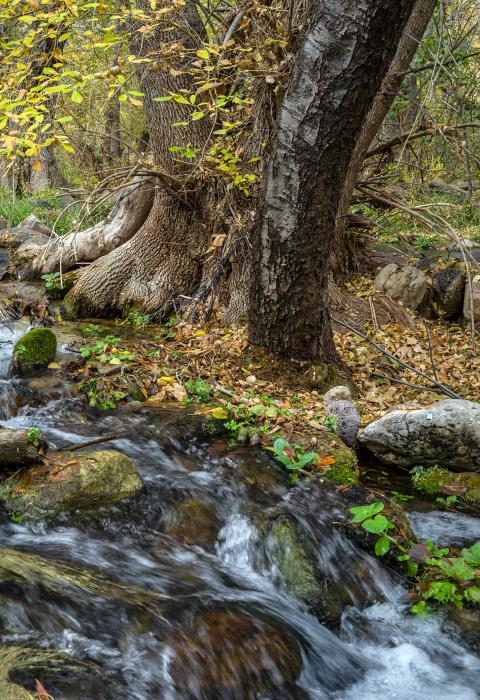Fossil Creek
Arizona
Fossil Creek has been described as the most diverse riparian area in Arizona. Over 30 species of trees and shrubs and over a hundred species of birds have been observed in this unique habitat. The stream seems to appear out of nowhere, originating from a collection of artesian springs that produce a constant, year-round flow of about 43 cubic feet per second. In a state where water is scarce, the magnitude and constant water flow of this perennial stream is rare.
For most of the last century, the stream was used for hydropower production through a series of diversion flumes that carried the majority of the flow from the springs to two power plants. Constructing this hydropower system in the early 1900's was a great engineering feat. In 2005, the hydropower project was decommissioned and flow was restored to the creek. In coordination with the decommissioning, a fish barrier was built, non-native fish were removed, and native fish were restored to Fossil Creek. It is now one of only a few streams in Arizona with only native fish and with ten federally listed or sensitive fish species either present or provided suitable habitat.
The water of Fossil Creek is also rare also because, as it comes out of the ground, it is supersaturated with calcium carbonate and forms travertine as it flows. In all of North America, there are only three travertine systems larger (with respect to water discharge and mineral deposition potential) than Fossil Creek, all of which are partially or wholly contained within national parks. The travertine creates terraces, steep waterfalls, and large pools and encases whatever happens to fall into the streambed, forming the fossils for which the area is named.
Designated Reach
March 30, 2009. From the confluence of Sand Rock and Calf Pen Canyons to its confluence with the Verde River.
Outstandingly Remarkable Values
Culture
The Apache and Yavapai began occupying the Fossil Creek corridor several millennia ago and up until the 1950s. Some evidence suggests the Yavapai entered Verde Valley as early as the 13th century, and the Apache arrived by 1500 AD. Both groups have occupied Fossil Creek at least intermittently since their arrival in the Verde Valley. The Yavapai and Apache lived a nomadic lifestyle; the Apache, in particular, developed farmland along Fossil Creek and would have returned seasonally to plant and harvest crops.
Life in the Fossil Creek corridor remained largely unchanged until the late 1860s and 1870s, when the U.S. Cavalry pursued an active campaign against the Yavapai and Apache. Only a few families remained by 1873 and lived in secrecy along Fossil Creek, remaining hidden from government troops. These few families that remained provided an unbroken cultural continuum between the people whose traditional religious practices predated contact with Anglo settlers and those who were either forced or born onto reservations and subjected to practices aimed at erasing their traditions.
Fish
Fossil Creek is home to a diverse native fish community, presently consisting of nine endangered, threatened, candidate, or Forest Service sensitive species. This includes the Colorado pikeminnow, razorback sucker, loach minnow, spikedace, Gila topminnow, roundtail chub, headwater chub, desert sucker, and Sonora sucker. This diverse fish population is unique in Arizona and thrives because of the removal of nonnative fish from the system.
After the dam removal, the Arizona Game and Fish Commission approved creating the country’s first-ever blue ribbon catch-and-release-only seasonal roundtail chub fishery along four miles of Fossil Creek. This catch-and-release started in October of 2009, and the season runs from the first Saturday in October through April 30th. Many enjoy fishing for native species in their native habitat, an uncommon opportunity in Arizona where most native fisheries have been depleted.
Geology
Early visitors to the area documented the existence of a series of extraordinary travertine dams that extended for some distance downstream from the spring sources that water Fossil Creek. Water that is supersaturated with calcium carbonate has the potential to create travertine structures that alter stream morphology. Travertine is chemically identical to the mineral calcite, which is distinguished from other forms of calcium carbonate by its banded and often porous structure.
In 1909, a 26-foot-high dam was built across Fossil Creek, and the entire baseflow was diverted through a flume system primarily for hydropower generation. After diversion of the baseflow, the in-channel travertine structures were breached and largely destroyed by episodic floods and debris flows. The decommissioning of the hydroelectric project and return of full flows to Fossil Creek have triggered rapid regrowth of travertine dams.
Recreation
Fossil Creek provides outstanding opportunities for a variety of recreational activities, and it attracts numerous visitors especially to the deep, clear pools in which to wade and swim. The constant water flow is welcome relief from the intense heat of the desert Southwest, and the dense riparian canopy provides visitors and wildlife with cooler temperatures. The springs that form Fossil Creek keep the water flow constant throughout the year, which is an uncommon characteristic in the Southwest desert. There is an abundance of deep, clear pools in which visitors can wade, swim, and snorkel. The beautiful blue-green color of the water is due to calcium carbonate dissolving in the water, which adds to the enjoyment of the area. Other attractions and opportunities include the 70° warm springs, camping, hiking, wilderness appreciation, fishing, wildlife and nature observation, photography, bird watching, and potential cultural and historical site interpretation.
Wildlife
Based on wildlife surveys and observation, Fossil Creek supports an estimate of 200 known bird, mammal, reptile, and amphibian species. There is also a possibility for an additional 300 species of mammals, birds, reptiles, and amphibians occupying Fossil Creek based on the diverse habitat available. There are about 80 special status species that are present or potentially present within the Fossil Creek drainage.

